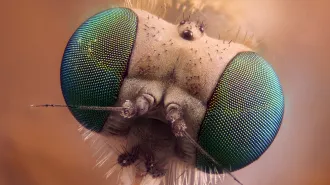A new drug can halt budding leukemia in mice by binding to a key protein on the surface of blood cells predisposed to becoming cancerous, researchers report in the July 2 Cell Stem Cell.
This and other studies have paved the way for preliminary testing of a version of the drug for people with acute myeloid leukemia, a particularly lethal form of the blood cancer. Fewer than one-third of patients diagnosed with this leukemia survive for five years.
The promising drug is an antibody that blocks a receptor called CD123 found on the surface of stem cells at risk of developing into leukemia cells, called leukemia stem cells. Normal blood stem cells serve as the templates for blood cells and various immune cells, but aberrant versions of these stem cells fail to develop properly and instead result in leukemia.
Earlier studies have shown that these leukemia stem cells are loaded with CD123, whereas normal blood stem cells have little or none of this protein, says study coauthor John E. Dick, a molecular biologist at the University of Toronto.
CD123 serves as a receptor, or docking port, for a signaling protein called interleukin-3. When interleukin-3 binds to CD123, the link-up tilts the aberrant cell’s path toward proliferation. This contributes to a flood of immature blood cells that crowd out healthy ones in the bone marrow — causing acute myeloid leukemia.
To intervene in this disastrous cycle, Australian researchers working with a mouse model of leukemia devised an antibody, called 7G3, and tested it in the new study. Dick teamed with the Australians to analyze the antibody’s effectiveness in lab dishes of normal and aberrant blood stem cells obtained from people with leukemia. These tests showed that 7G3 specifically targeted leukemia stem cells. And by locking onto the CD123 receptors on these cells, the drug blocked interleukin-3 binding. This jammed signaling in the cells and prevented replication, Dick says. The antibody had no effect on normal blood stem cells, the team notes.
Tests on mice implanted with human leukemia stem cells showed that animals treated with the antibody survived on average for 24 weeks, compared with only 12 weeks for similar mice not getting the drug. The mice getting the antibody also showed less evidence of the leukemia stem cells migrating to bone marrow, which is a necessary step for developing full-blown leukemia, Dick says. In general, the antibody worked best when given early, the authors note.
The mice experiments suggest that preventing the interleukin-3 binding also flags the cell for destruction by the immune troops, Dick says.
These findings, coupled with previous research, “suggest that the targeting of CD123 is a strategy clinically relevant and with a potentially acceptable safety profile,” says Ugo Testa, a medical oncologist at the Institute Superior of Health in Rome. “In a clinical setting, treatment with anti-CD123 drugs could be scheduled after initial standard chemotherapy … to eliminate residual leukemic stem cells.”
A mouse antibody like 7G3 would be rejected by the human immune system. So the Australian team has started treating leukemia patients with a synthetic version of the drug that caused no ill effects in monkeys. That version of the drug has been scrubbed of its mouse-related components. So far, the researchers have not released findings from that study apart from preliminary information showing that the drug appears to be safe.
Testa, whose team first showed that CD123 was overproduced in leukemia cells, adds that the new work “may also represent an important starting point for the development of similar anticancer therapies” for malignancies, such as chronic myeloid leukemia, with stem cells that aren’t killed by current drugs but that do overproduce specific cell-surface receptors that could be targeted with an antibody therapy.







